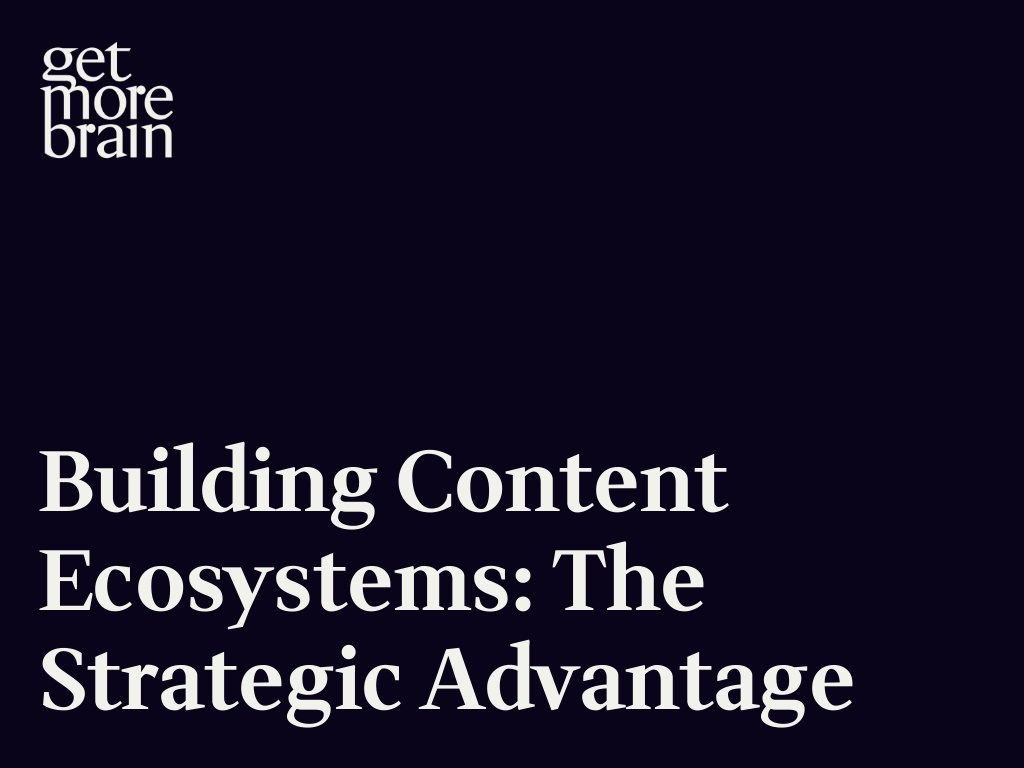Building Content Ecosystems: The Strategic Advantage

- Roman Schurter
Content is no longer a static asset confined to a single channel. The most successful organizations have shifted to thinking in terms of content ecosystems – interconnected networks where content flows seamlessly across platforms, formats, and touchpoints.
We’ve seen firsthand how this ecosystem approach transforms content from a cost center into a strategic asset with multiplying returns. Let’s explore what makes content ecosystems so powerful and why they’re worth investing in.
What Is a Content Ecosystem?
A content ecosystem is like a vineyard – everything is connected, nothing goes to waste. It’s a holistic approach where content is created, distributed, and optimized through an interconnected network of platforms, channels, and touchpoints.
At its core, a content ecosystem has:
- A centralized content hub serving as the single source of truth
- Multiple distribution channels that leverage the same content assets
- Feedback loops that capture user insights
- Monetization mechanisms across various touchpoints
Instead of creating isolated content pieces for different platforms, a content ecosystem approach allows organizations to maximize their ROI by creating once and publishing everywhere.
The Power of Reusability: Create Once, Use Everywhere
One of the most compelling aspects of content ecosystems is their inherent efficiency. We’ve worked with publishers who transformed a single cultural guide into a print publication, podcast series, microlearning modules, and partner content integrations – all from the same source material.
This “create once, use everywhere” approach offers several advantages:
- Dramatically reduced production costs per content asset
- Faster time-to-market across all channels
- Consistent messaging and branding
- Ability to experiment with formats without starting from scratch
For example, a Standards Development Organization (SDO) could create their technical documentation in a structured format that automatically feeds their website, print publications, mobile app, and even third-party software integrations – all from a single source.
Feedback Loops: The Gold Mine of Content Ecosystems
A content ecosystem isn’t just about pushing content out – it’s equally about what comes back. Smart publishers are building bidirectional channels that turn passive consumers into active participants.
Double your product ideas by implementing feedback functionality within your content ecosystem. These feedback mechanisms provide invaluable insights that drive:
- Content optimization based on actual usage patterns
- New product development informed by user needs
- Community building around content assets
- Continuous improvement cycles
The organizations seeing the greatest success are those that systematically analyze and act on this feedback, creating a virtuous cycle of improvement.
Beyond Direct Sales: API-First Monetization
Monetization in a content ecosystem extends far beyond traditional sales channels. With an API-first architecture, content becomes a service that can be embedded into third-party tools and platforms – opening new revenue streams.
This approach:
- Creates recurring revenue streams
- Reaches users in their natural workflow
- Increases the perceived value of content
- Builds strategic partnerships with tool providers
By thinking of content as modular, API-accessible assets, publishers can tap into the platform economy and generate revenue where their content delivers the most value.
Strategic Content Partnerships
A content ecosystem isn’t limited to your own proprietary content. The most robust ecosystems integrate multiple content sources to create greater value:
- Partner publishers: Strategic content partnerships can fill gaps in your expertise while expanding your reach into new audiences.
- Expert contributors: Subject matter experts bring specialized knowledge and credibility that enhances your ecosystem’s authority.
- User-generated content: Your audience becomes active participants, adding perspectives and real-world applications of your content.
Your organizations can leverage this collaborative approach to tremendous effect.
💡 Accelerate content creation through distributed authorship
💡 Increase engagement as users see themselves represented
💡 Surface innovative use cases the original publishers hadn’t considered
💡 Create natural network effects as contributors share their contributions
The key is maintaining consistent quality standards and clear attribution while allowing for diverse voices and perspectives to enrich your ecosystem.
Building Your Content Ecosystem: Where to Start
Creating a robust content ecosystem doesn’t happen overnight, but there are practical steps organizations can take to begin the journey:
- Audit your content: Identify your most valuable content assets and understand how they could be repurposed across channels.
- Establish a central repository: Create a single source of truth for all your content, with proper tagging and metadata.
- Implement structured content: Move toward a component-based approach that enables content reuse and recombination.
- Start with one cross-channel flow: Pick a high-value content type and create a process for distributing it across multiple platforms.
- Build feedback mechanisms: Add simple ways for users to engage with and provide input on your content.
The key is to start small, prove the concept, and then expand based on what works for your specific audience and business goals.
The Future of Content Is Interconnected
As digital channels continue to proliferate and user expectations evolve, the organizations that thrive will be those that build robust content ecosystems. They’ll create content once, distribute it widely, capture valuable feedback, and monetize through multiple channels – all while delivering superior user experiences.
We believe content ecosystems represent not just an operational improvement but a fundamental shift in how organizations think about and leverage their content assets. The publishers, associations, and corporate content teams that embrace this approach now will gain a significant competitive advantage in the years ahead.
